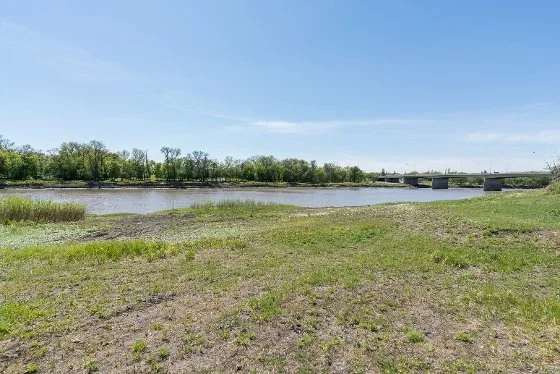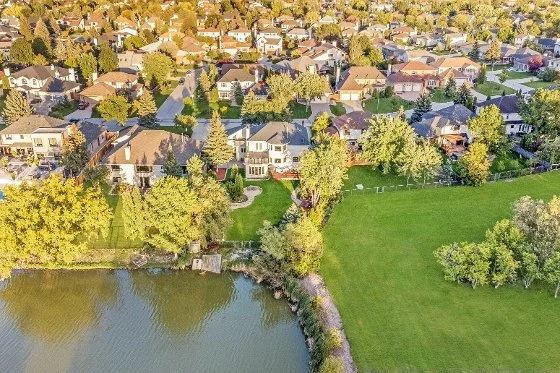Buying Riverfront or Waterfront property in Winnipeg, Manitoba
I have had the pleasure of helping many people buy and sell homes on water within Winnipeg over the years, and it seems that the same questions often come up, so let’s go through them now!
Understanding the Challenges with Riverfront Living
Firstly, living on the Red River in Winnipeg, is very different from living on a lakefront or man-made lake waterfront home within Winnipeg. A river is constantly moving, oftentimes damaging or slowly eroding the riverbed. Secondly, and for those not from Manitoba, we are not built on bedrock here. Our landscape is a full mess of what we call “Manitoba Gumbo” which is essentially sand, silt, and clay. The stuff that rivers can more easily move around than bedrock or granite. As such, maintenance of the riverbank is critical to not losing your yard over time. I want to preface this blog by saying that I am not an expert in this area – because I am not, at all! However, Logan and I do live on the Red River and we have sold a number of homes along the Assiniboine River, Seine River, La Salle, and Red River as well as the smaller creeks (Bunn’s, Omand’s, etc.) here in Winnipeg. The degree and effort you are going to be required to put into your Riverbank Stabilization will greatly depend on the current or flow patterns coming past your property and which side of the river you are on. The Red River flows north, and depending on the curvature and current coming toward your property, the impact might be minimal. The river tends to remove soil on outside curves but it deposits it on inside curves. However, if you are on a heavier flowing area, the amount of work required for maintenance can be substantial.
Oftentimes, the loss of lot is not something that people can foresee. A super high-water year led to a group of residents along Dunkirk Drive losing large chunks of their yard in 2020. Keep in mind too, that this is not something that insurance companies are willing to cover. In this particular instance, the residents all banded together to repair their riverbank at a cost of around $1 million. Another key consideration for those living along the river is that you often need permits from the City of Winnipeg to do any sort of riverbank stabilizing project. As part of being approved for said permits, you often will need an engineer’s report that addresses the erosion issue. These studies are quite costly and oftentimes take a significant amount of time to complete. Not to mention the city permitting process adding to that timeline. Some patience will be required here.
At the Mercy of Due Process
The next hurdle you are going to have is to actually address what the engineer’s report says. I have seen circumstances where the recommendation was to add a significant amount of rip-rap (this looks like large stones along the riverbank). This helps reduce erosion. However, this can come at a significant cost. I have seen some of the bills for this type of work and would say that $100,000 per household often seems to be the going or starting rate for the more significant projects. Imagine spending that on rocks instead of some fun renovation within the home!
Interestingly enough, I have actually had a client that had the exact opposite issue brought to their attention from the engineers. In their case, the home they were purchasing was putting too much weight on the land, and they were told to move the home back, away from the river, remove additional dirt from the lot and move it further back. So, they did all of this work – moved their house further back, actually added onto it, removed dump truck after dump truck of dirt, and the erosion stopped. I still don’t understand the actual logistics of how this theory worked, but it was cool nonetheless. The property they built was absolutely beautiful. Their neighbour, who couldn’t afford to “lighten” his yard unfortunately continued to experience the same erosion and has much less yard now.
There are things you can do though to prevent erosion on your own property without having to go all the way to hiring engineers and getting permits. One of the cheapest and easiest options is to plant some trees. Choose trees with deep root systems, that will hold soil in place and withstand some erosion. There are also many shrub varieties that also offer dense and deep root structures that you can plant to as not to obstruct those river views. Also, I see no harm in doing annual work along your property line to prevent erosion. Perhaps some smaller forms of the huge rip-rap projects, brought in every few years just to maintain what you currently have, instead of having to try and rebuild lot that you have lost.
Personal Experiences from Living on the Red River
Just some other negatives from having lived on the Red River – Logan and I have almost always had dogs – often times Labradors which are water-lovers. There are many a time our dog has taken herself for a “dip” and coming out of the Red River is not the same as coming out of a clean lake. There is often an additional bath required after this “dip”. Also, the river moves fast – and it is terrifying when your children are young. Our yard is fenced and our children know not to go outside of the fence unless there is a parent present. We are also very hands on with the education and stress every time we go beyond the borders of the fence just how dangerous the river is. A lot of the time, you can’t tell if you are standing out on a dirt plank because the ground underneath has eroded. So, if we are out for walks along the riverbank with the children, we stress the importance of staying several meters back from the edge.
We have also discovered when applying for permits for work on the exterior of our home is that we have to go through two rounds of permitting. First, we apply for permission from the City of Winnipeg to do our project. But then we have to apply for a second permit from Waterways to get permission prior to commencing any construction. These rules apply to anyone that is within 350 feet of the summer water levels of the Assiniboine River, Red River, Seine River, La Salle Rivers, OR within 250 feet of the summer water levels of Bunn’s Creek, Omand’s Creek, Sturgeon Creek or Truro Creek. This is if you are within City limits. This process changes if you are outside of the City of Winnipeg limits.
Pros to living on Winnipeg Riverfront
Pros of living on the Riverfront in Winnipeg are great though, here are just a few:
The neighbours – we are on a deep river lot with neighbours on either side, but I find that riverfront lots often tend to be wider and more spread out, so we feel like we have a ton of space and privacy from our neighbours. We particularly enjoyed this during the early stages of COVID where we could walk to the end of our yard and then along the riverbank for hours without seeing neighbours.
The views. The river offers lots of beautiful scenery – beautiful glistening sunlight reflections on hot summer days, or huge icebergs to watch float on by in the winter months. We are east-facing so we also enjoy some of the most beautiful sunrises in our house.
The wildlife. Living on the riverbank means you are likely going to encounter a fair bit of wildlife. I would be lying if I said I didn’t see a deer, daily. I think every time we sit down at our table for a meal, at least one deer will walk by. There are very few predators within city limits, so the deer seem quite comfortable walking on by even when we are outside. We do on occasion see the odd fox or coyote trying to track down one of the neighbourhood bunnies. Also, and this could be added as a con, but we do get some nuisance animals. We have seen a number of raccoons (although we haven’t had any negative experiences with them). However, we – actually our dog – have had a nasty bout with a skunk on more than one occasion.
Fishing – truthfully, we have never done it. But I see people pull up in the green spaces in our area to fish the river and it seems to be the same group that comes back again and again, so I am assuming we could likely catch some fish right from our backyard. I grew up on Lake of the Woods though, so river fishing is a foreign concept to me. Perhaps one I will explore one day!
Recreation activities – our family’s fitness or recreation activities thus far have been mostly walking along the trails of the river. However, I have witnessed neighbours putting a kayak in and getting what I would assume is a good workout in! But be careful with this. You need to know the river, the current patterns, and you need to be a strong kayaker. Also, please always wear a life vest. That water can move fast and I’ve heard of even the most seasoned kayakers getting into trouble.
Travel – We have never done it, as we are scared of hitting dead logs in the river as we travel, but I always thought it would be so cool to hop in a boat and drive down to the Forks. Maybe one day! I have had clients just across the river from us that kept a dock in the river all summer, and would hop in their boat frequently and go for a cruise!
Pros of living on a Lakefront or Waterfront Property in Winnipeg
Now these pros and cons work for riverfront property in Winnipeg, but there are further benefits to owning a Waterfront home in Winnipeg on a man-made lake. Not only would you get all of the above benefits, but when you are on a slower-moving body of water, there are additional perks:
In the winter, you can build an ice skating rink right on the water surface. Something that is often not possible on parts of the river due to the quick flow and thin ice.
Putting a kayak into these bodies of water also isn’t nearly as scary. The water movement is much more controlled so even those less experienced kayakers can paddle in piece.
Less overall maintenance. A Lakefront property in Winnipeg on a manmade lake does not require anywhere near the riverbank stabilization that a home built on the river will need. With basic, annual maintenance, you should be able to enjoy your shoreline for years to come.
Less building restrictions – if you aren’t on one of the aforementioned rivers, you have one less layer of permitting that you will have to go through too!
I hope you have found this foray into Lakefront property for sale in Winnipeg, useful. There is much to know, and many considerations to be made. Again, I say all of these horrible and scary things about riverfront living in Winnipeg, yet I live on it. So either I am crazy, or to me, the beauty and peacefulness is worth the headache. You be the judge! If ever you are looking for help in finding a lakefront or riverfront property in Winnipeg, please reach out. We are happy to help and we will speak from our honest experiences!




